Looking for a student learning guide? It’s on the main menu for your course. Use the “Courses” menu above.
1. Introduction: What is Homeostasis?
 Imagine, as in the image shown at left, that you were trying to balance yourself on a board. You’d be adjusting your weight left and right. Each moment, your legs would shift position, as would your arms. If you were outdoors, and the wind blew from your left, you might compensate by leaning to the right.
Imagine, as in the image shown at left, that you were trying to balance yourself on a board. You’d be adjusting your weight left and right. Each moment, your legs would shift position, as would your arms. If you were outdoors, and the wind blew from your left, you might compensate by leaning to the right.
That process of trying to maintain your balance is the essence of homeostasis: the tendency of a living system to maintain its internal stability as a result of the coordinated responses of its parts to any stimulus that would tend to disturb its normal conditions. (adapted from Dictionary.com).
What are these normal conditions? Here are just a few:
- We’re mammals, so our body temperature fluctuates in a narrow range of around 37°C.
- Our blood’s pH is slightly alkaline, between pH 7.35 and pH 7.45.
- Our blood glucose level fluctuates. It rises immediately after eating, and then a variety of homeostatic mechanisms lower it to what’s called the “fasting level.” At that point (several hours after eating) it should be between 70 and 99 mg/dL. Above that level, you might be at risk for diabetes.
Keeping these conditions (and many others) within a healthy, life-sustaining range is what homeostasis is all about. Let’s see how it works.
2. Regulators and Conformers
 The first thing to note is that not all organisms regulate internal conditions to the same degree. Look at this graph showing the body temperature of a snake and a coyote. As the external temperature fluctuates, so does the snake’s internal temperature. That makes the snake, in terms of body temperature, a conformer. Its body temperature conforms to the temperature of the external environment. By contrast, the coyote, in terms of body temperature, is a regulator. Whether the external temperature is high or low, the coyote (like all mammals) works to keep its body temperature at a constant 37°C.
The first thing to note is that not all organisms regulate internal conditions to the same degree. Look at this graph showing the body temperature of a snake and a coyote. As the external temperature fluctuates, so does the snake’s internal temperature. That makes the snake, in terms of body temperature, a conformer. Its body temperature conforms to the temperature of the external environment. By contrast, the coyote, in terms of body temperature, is a regulator. Whether the external temperature is high or low, the coyote (like all mammals) works to keep its body temperature at a constant 37°C.
Note that both strategies have benefits and drawbacks. It takes work to regulate. In the case of body temperature regulation, that work has to be fueled by food energy. As a result, for each kilogram of body weight, the daily energy requirements of a mammal are much higher than the daily energy requirements of a reptile. For example, a human being who weighs 81 kilograms (about 180 lbs) requires about 2700 calories of food/day. You can think of that as about 27 slices of bread or an equal number of medium-sized potatoes. An alligator with the same weight would require only about 1/10th of the food energy. So that’s a possible drawback. But the benefit is that a mammal can stay active at low temperatures. Hence, mammals can survive in cold environments that would be impossible for reptiles.
In terms of body temperature regulation, here are a couple of terms to know. Ectotherms are organisms that get heat from the external environment. Most ectotherms are conformers, and because their body temperature fluctuates with the environment, they’re also called poikilotherms. However, ectotherms aren’t completely at the mercy of the external environment; behavioral strategies such as moving into the sun to warm up or moving into the shade to cool down are ways that ectothermic animals will use the environment to keep their temperatures within an optimal range. By contrast, endotherms generate their heat internally, mostly as a result of heat generated during cellular respiration. Endotherms tend to be regulators, and the term homeotherm is used to describe their tendency to keep their body temperature constant.
3. Checking Understanding: Homeostasis, Regulating, and Conforming
[qwiz qrecord_id=”sciencemusicvideosMeister1961-M26, Homeostasis, Regulating, and Conforming”]
[h]Homeostasis, Regulators, Conformers, and Body Temperature
[i]
[q] The tendency of a living system to maintain internal stability, even in the face of external change, is called [hangman].
[c]IGhvbWVvc3Rhc2lz[Qq]
[q]A [hangman] allows an internal variable to rise and fall as the outside environment changes.
[c]Y29uZm9ybWVy[Qq]
[q]A [hangman] works to maintain an internal condition in a constant range, despite environmental changes.
[c]cmVndWxhdG9y[Qq]
[q]In most cases, being a [hangman] requires much more energy than being a [hangman]
[c]cmVndWxhdG9y[Qq]
[c]Y29uZm9ybWVy[Qq]
[q]A(n) [hangman] gets its body heat from the external environment.
[c]ZWN0b3RoZXJt[Qq]
[q]A(n) [hangman] generates its body heat internally, usually as a byproduct of cellular respiration.
[c]ZW5kb3RoZXJt[Qq]
[q]The body-temperature-related term for a regulator for body temperature is [hangman].
[c]aG9tZW90aGVybQ==[Qq]
[q]The body temperature-specific term for a conformer for body temperature (such as “a” below) is a [hangman].
[c]cG9pa2lsb3RoZXJt[Qq]
[q]When it comes to body temperature, almost all mammals generate their body heat internally, making them [hangman]. Because mammals regulate their body temperature, keeping it in a narrow range around 37 C, they’re also [hangman].
[c]ZW5kb3RoZXJtcw==[Qq]
[c]aG9tZW90aGVybXM=[Qq]
[q]In the diagram below, the general term for the type of homeostatic regulation shown by “A” would be [hangman]
[c]Y29uZm9ybWVy[Qq]
[q]In the diagram below, the general term for the type of homeostatic regulation shown by “B” would be [hangman]
[c]cmVndWxhdG9y[Qq]
[x][restart]
[/qwiz]
4. Adaptations for Body Temperature Regulation
Let’s look at some general mechanisms by which organisms can control their body temperature. Most of these apply to homeotherms like mammals and birds, and function to minimize the amount of work they need to do to keep their body temperature constant.
a. Insulation
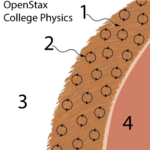
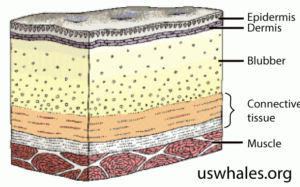
Mammals and birds that live in cold environments use fur (1 at left) or feathers to trap a layer of air (2) next to their bodies (4). Blubber, a thick layer of insulating fat, is another type of insulation that’s particularly important for marine mammals like whales and walruses.
Note that insulation doesn’t have to be an all-or-nothing kind of adaptation. If you have a dog that sheds its coat in the winter, then you’re aware that fur-based insulation can be seasonal. Mammals also have tiny muscles attached to their hair follicles that are called arrector pili. Contraction of these muscles causes hair or fur to stand on end. This increases the amount of air that hair or fur can trap. When you feel goosebumps from the cold you’re experiencing a vestige of this adaptation: we humans still have the muscles, but we’ve lost most of the insulating body hair.
b. Evaporative cooling

When water molecules evaporate from the skin (or other surfaces), they carry heat energy away from the body, lowering body temperature. This is called evaporative cooling: cooling that happens through evaporation. In humans, evaporative cooling occurs through sweating. Sweat glands (1, above) release sweat (3) onto the skin (2). Number 4 indicates evaporation.
In dogs and other animals, evaporative cooling occurs through panting. If you’ve seen a video of elephants squirting water onto their backs on a hot day, that’s another way to bring about evaporative cooling.
C. Vasodilation and Vasoconstriction
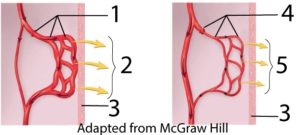
Vasodilation and vasoconstriction can be used to promote and prevent heat loss. In vasodilation (1, at left) blood vessels that supply the skin and other extremities with blood relax. This allows blood to get closer to the body’s outer surface, which in turn allows heat (2) to radiate from the blood, through the skin (3), and out into the environment. This is also called radiative cooling. When your skin feels flushed, that’s vasodilation. In vasoconstriction (4), the blood vessels supplying the skin and extremities constrict. This keeps blood from flowing close to the skin, decreasing the amount of heat that can flow from the blood out to the body (notice the smaller arrow at “5”). The key thing to remember is that vasodilation increases radiative cooling, while vasoconstriction decreases it.
D. Countercurrent exchange to minimize heat loss
Countercurrent exchange systems are anatomical adaptations that keep heat in the body’s core. Extremities like the feet are allowed to drop in temperature, and circulating blood is organized in a way that minimizes heat loss to the environment.
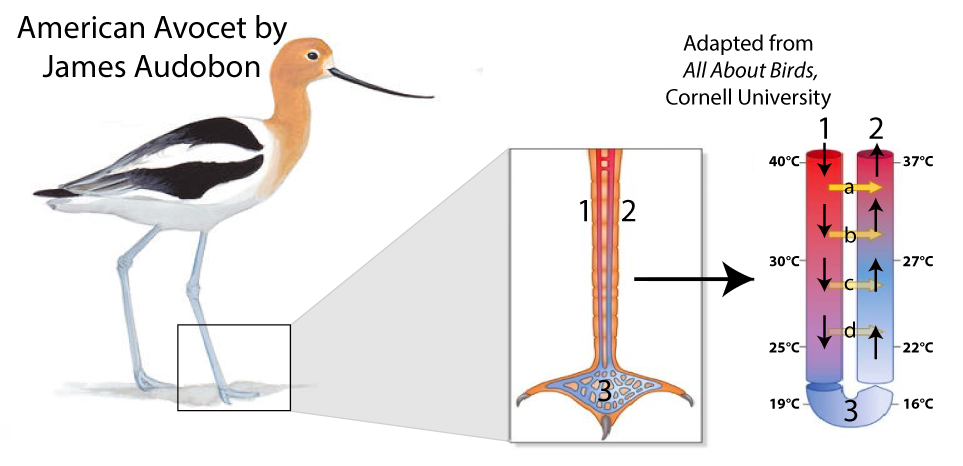
Consider the American Avocet, a shorebird that spends its days wading in along the shores of, among other places, the San Francisco Bay. The water temperature might be 15°C, while the bird’s body temperature runs about 40°C (a bit warmer than us mammals).
If the blood that the avocet was circulating to its legs came back into the bird’s body at 15°C, it would take a lot of energy to warm that blood back up to 40°C. The avocet avoids that energy expenditure through two adaptations. First, the temperature in the legs can drop significantly below the bird’s core body temperature, with no ill effect on the bird’s overall health. That shouldn’t sound too extraordinary to you; the temperature of your feet is probably significantly below 37°C (your core body temperature).
Secondly, outgoing arteries, with warm blood from the body’s core, are interior to and pressed right up against the more exterior veins, which bring blood back to the body. With this arrangement, there’s always a slight temperature gradient. Heat will leave the artery (shown at “1”) and diffuse into the vein (at “2”). At the foot (“3”), the blood will be quite cold (nearly the temperature of the environment). But by the time the blood is ready to reenter the core (at “a”) it has warmed up just below the bird’s body temperature, and very little energy needs to be spent to bring it up to 40°C.
E. Adjusting Surface Area
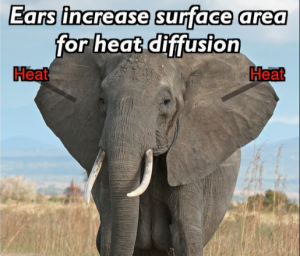 On an evolutionary scale, animals have evolved body surfaces in response to thermoregulatory demands. Animals in hot environments often have large flaps of skin that act as heat radiators. Examples include the ears of elephants or jackrabbits.
On an evolutionary scale, animals have evolved body surfaces in response to thermoregulatory demands. Animals in hot environments often have large flaps of skin that act as heat radiators. Examples include the ears of elephants or jackrabbits.
The size of whales can also be explained as an adaptation for thermoregulation. As the ancestors of whales colonized the seas over the past 50 million years, a selective factor guiding their evolution was the energy required to maintain their mammalian body temperature while in cool ocean water. In this context, any ancestral mammal that was too small would be at a disadvantage. Why? Because small animals have a lot of surface area relative to their volume. A small body would radiate a lot of heat into the environment, requiring lots of energy to keep the core temperature at the mammalian set point of 37C. As a result, there’s a minimum body size for marine mammals: none are smaller than sea otters. At the same time, as far as thermoregulation goes, bigger is better. The larger an animal’s body, the smaller its ratio of surface area to volume. So it’s no wonder that whales evolved to be the largest animals on earth. Just by evolving to be big, they’ve reduced the relative amount of energy they need to keep their bodies warm. You can review all of this in my tutorial about surface area and volume.
F. Thermoregulatory Behaviors
In addition to the structural adaptations and physiological responses listed above, there are also a host of behaviors that animals use to thermoregulate. When ectothermic lizards are basking in the sun, they’re raising their body temperature. When they’re too hot, they move into the shade. We mammals, despite our ectothermic metabolisms, do the same.
5. Body Temperature (and many other Homeostatic Variables) is Regulated by Negative Feedback
Now that we’ve looked at various adaptations for regulating body temperature, let’s learn about how homeothermic organisms maintain their body temperature at a constant level. The key principle is negative feedback: a control mechanism in which the output of a system feeds back into the system in a way that reduces the system’s output.
5a. A Domestic Example
This might sound abstract, but many of us have such a system in our homes. I’m referring to the thermostat that works with a home’s heating system to keep the temperature in a home constant.

Thermostats consist of a thermometer (1) that is connected to a control mechanism (represented by “2:” it’s the entire device). The control lets you set the desired temperature, called a set point (at “b”). In this diagram, the set point is 68°F (20°C). Because the set point is above the room temperature (shown at “a:” 66°F), the thermostat sends a message (“4”) to a furnace (at “c”). The furnace releases heat (“5”).
The warming of the room feeds back (“6”) to the thermometer. Imagine the temperature rising to 67°F, then 68°F. At that point, the thermostat would send a message to the furnace to turn off. It’s negative feedback because the output of the system (heat) turns the system off. It’s also an artificial form of homeostasis.
Some homes have more elaborate systems, with both heating and cooling.
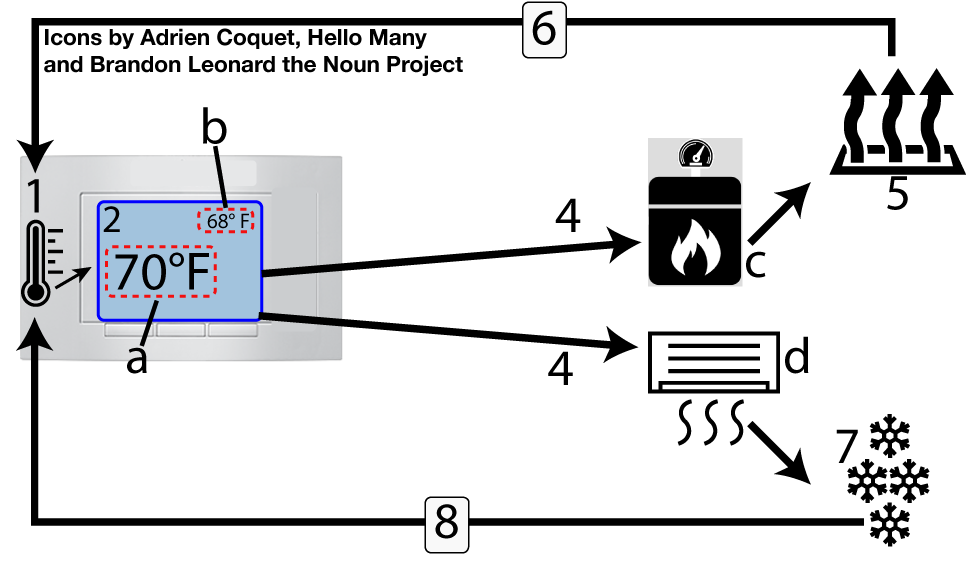
Imagine that it’s summer, and the temperature inside your home is climbing. Your set point is still the same (68°F/20°C). If the temperature climbs above the set point, then there’s nothing that the heater can do. But if you have an air conditioner (“d”) then your thermostat will direct the air conditioner to blow cold air into your house (represented by the snowflakes at “7.”) As your house cools, the temperature change will feed back (8) to the thermostat. When the temperature drops back down to the set point, the air conditioner will receive a message to turn off. Again, it’s negative feedback, because the system’s output turns the system off. But it’s negative feedback with two antagonistic effectors, each with opposite effects. That, as we’ll see below and in the next tutorial, is a typical organization of homeostatic mechanisms in living things as well.
5b. The Hypothalamus is our Body’s Thermostat
In mammals, body temperature regulation is under the control of the hypothalamus, a region deep within the brain that’s also responsible for regulating hunger and thirst (among its other functions).
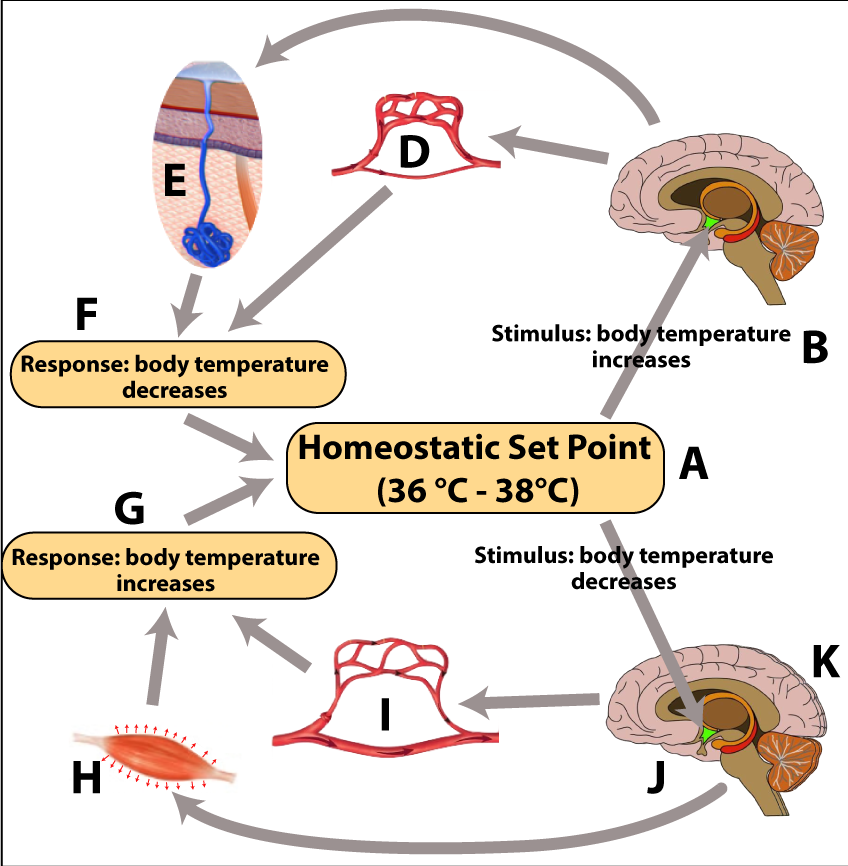
The hypothalamus is shown above as the green region within the brain (though please note that the green color was just to draw your attention). Like the thermostat shown above, the hypothalamus works its effects through negative feedback.
When body temperature increases (B), the hypothalamus directs two responses. Letter “D” shows vasodilation, while letter “E” shows sweating. This combination of radiative and evaporative cooling (see above for more details) cools the body (F) back to its set point.
When body temperature decreases the hypothalamus directs the superficial arteries to vasoconstrict (I), which reduces radiative heat loss. Shivering (H) generates heat to warm the body. Together, these two responses return the body to the set point.
6. Checking Understanding: Homeostasis, Negative Feedback, and Thermoregulation
[qwiz qrecord_id=”sciencemusicvideosMeister1961-M26, Homeostasis, Negative Feedback, and Thermoregulation”]
[h]Homeostasis, Negative Feedback, and Thermoregulation
[i]Biohaiku
Homeostasis
Keeping conditions inside
Conducive for life
[q] The diagram below shows how mammals can use fur (“1”) to trap a layer of [hangman] that insulates their bodies (“4”) from the colder environment. This adaptation reduces the amount of [hangman] required to keep their bodies warm.
[c]IGFpcg==[Qq]
[f]IEV4Y2VsbGVudCE=[Qq]
[c]IGVuZXJneQ==[Qq]
[f]IEdyZWF0IQ==[Qq]
[q] In the diagram below, the question mark shows how a thick layer of [hangman] can provide insulation in animals like marine mammals (particularly whales).
[c]IGJsdWJiZXI=[Qq]
[f]IEV4Y2VsbGVudCE=[Qq]
[q] The diagram below shows how [hangman] (at “3”) can reduce body temperature through a process called [hangman]
cooling.
[c]IHN3ZWF0[Qq]
[f]IEdvb2Qh[Qq]
[c]IGV2YXBvcmF0aXZl[Qq]
[f]IEdvb2Qh[Qq]
[q] The diagram below contrasts [hangman] shown at number “1,” with [hangman], shown at “2.”
[c]IHZhc29kaWxhdGlvbg==[Qq]
[f]IEdyZWF0IQ==[Qq]
[c]IHZhc29jb25zdHJpY3Rpb24=[Qq]
[f]IEdvb2Qh[Qq]
[q] Vasodilation [hangman] the amount of [hangman]that an organism can radiate into the environment by allowing more [hangman] to reach the tissues just underneath the outer layers of the [hangman].
[c]IGluY3JlYXNlcw==[Qq]
[f]IEdvb2Qh[Qq]
[c]IGhlYXQ=[Qq]
[f]IEdvb2Qh[Qq]
[c]IGJsb29k[Qq]
[f]IENvcnJlY3Qh[Qq]
[c]IHNraW4=[Qq]
[f]IEdvb2Qh[Qq]
[q] The diagram below illustrates how in a(n) [hangman] exchange system, outgoing blood in an [hangman] (at “1”) exchanges heat with incoming blood in a [hangman]. As a result, the temperature in extremities can drop way[hangman]the temperature in the body’s core, but the temperature of the blood entering the core is never more than a few degrees less than body temperature, which preserves a lot of[hangman].
[c]IGNvdW50ZXJjdXJyZW50[Qq]
[f]IENvcnJlY3Qh[Qq]
[c]IGFydGVyeQ==[Qq]
[f]IEdyZWF0IQ==[Qq]
[c]IHZlaW4=[Qq]
[f]IENvcnJlY3Qh[Qq]
[c]IGJlbG93[Qq]
[f]IEdyZWF0IQ==[Qq]
[c]IGVuZXJneQ==[Qq]
[f]IENvcnJlY3Qh[Qq]
[q] The ears of the jackrabbit shown below are an adaptation for increasing body [hangman] [hangman]. This allows heat to more easily diffuse from the rabbit’s [hangman] into its environment.
[c]IHN1cmZhY2U=[Qq]
[f]IEdvb2Qh[Qq]
[c]IGFyZWE=[Qq]
[f]IENvcnJlY3Qh[Qq]
[c]IGJsb29k[Qq]
[f]IENvcnJlY3Qh[Qq]
[q] The diagram below is showing a type of engineered homeostasis that works through [hangman] feedback.
[c]IG5lZ2F0aXZl[Qq]
[q] In the diagram below, number ____ is showing negative feedback that will turn off the heating system.
[textentry single_char=”true”]
[c]ID Y=
[f]IEV4Y2VsbGVudC4gJiM4MjIwOzYmIzgyMjE7IHNob3dzJiM4MjIxOyBob3cgaGVhdCBpcyBmZWVkaW5nIGJhY2sgdG8gdGhlIHRoZXJtb3N0YXQgaW4gYSB3YXkgdGhhdCB3aWxsIHR1cm4gb2ZmIHRoZSBoZWF0ZXIgb25jZSB0aGUgdGVtcGVyYXR1cmUgaW4gdGhlIHJvb20gcmlzZXMgdG8gdGhlIHNldCBwb2ludC4=[Qq]
[c]IEVudGVyIHdvcmQ=[Qq]
[c]ICo=[Qq]
[f]IE5vLiBGaW5kIHRoZSBudW1iZXIgdGhhdCBzaG93cyBoZWF0IGZlZWRpbmcgYmFjayB0byB0aGUgdGhlcm1vc3RhdCYjODIxNztzIHRoZXJtb21ldGVyLg==[Qq]
[q] In the diagram below, which letter or number indicates the set point?
[textentry single_char=”true”]
[c]IG I=
[f]IE5pY2Ugam9iLiBMZXR0ZXImIzgyMjE7YiYjODIyMTsgaW5kaWNhdGVzIHRoZSBzZXQgcG9pbnQu[Qq]
[c]IEVudGVyIHdvcmQ=[Qq]
[c]ICo=[Qq]
[f]IE5vLiBJbiB0aGlzIGNhc2UsIHRoZSBzZXQgcG9pbnQgaXMgdGhlIGRlc2lyZWQgdGVtcGVyYXR1cmUgKGFzIG9wcG9zZWQgdG8gdGhlIGFjdHVhbCB0ZW1wZXJhdHVyZSwgd2hpY2ggaXMgaW5kaWNhdGVkIGJ5IHRoZSBsZXR0ZXIgJiM4MjIwO2EmIzgyMjE7KS4=[Qq]
[q] In the diagram below, which letter indicates a process that would result in evaporative cooling?
[textentry single_char=”true”]
[c]IE I=
[f]IEF3ZXNvbWUuIExldHRlciAmIzgyMjA7QiYjODIyMTsgaW5kaWNhdGVzIHN3ZWF0aW5nLCB3aGljaCBjYW4gYnJpbmcgYWJvdXQgZXZhcG9yYXRpdmUgY29vbGluZy4=[Qq]
[c]IEVudGVyIHdvcmQ=[Qq]
[c]ICo=[Qq]
[f]IE5vLiBMb29rIGZvciBhIHByb2Nlc3MgdGhhdCB3b3VsZCBzZWNyZXRlIHdhdGVyIG9udG8gdGhlIHNraW4sIGFsbG93aW5nIGZvciBldmFwb3JhdGl2ZS4=[Qq]
[q] In the diagram below, which letter indicates a process that would result in radiative cooling?
[textentry single_char=”true”]
[c]IE E=
[f]IEF3ZXNvbWUuIFRoZSBsZXR0ZXIgJiM4MjIwO2EmIzgyMjE7IGluZGljYXRlcyB2YXNvZGlsYXRpb24sIHdoaWNoIGNhbiBicmluZyBhYm91dCByYWRpYXRpdmUgY29vbGluZy4=[Qq]
[c]IEVudGVyIHdvcmQ=[Qq]
[c]ICo=[Qq]
[f]IE5vLiBMb29rIGZvciBhIHByb2Nlc3MgdGhhdCB3b3VsZCA=aW5jcmVhc2U=IHRoZSBhbW91bnQgb2YgaGVhdCByZWxlYXNlZCBmcm9tIHRoZSBibG9vZCBpbnRvIHRoZSBlbnZpcm9ubWVudC4=[Qq]
[q] In the diagram below, which letter indicates vasoconstriction?
[textentry single_char=”true”]
[c]IE M=
[f]IEF3ZXNvbWUuIExldHRlciAmIzgyMjA7QyYjODIyMTsgaW5kaWNhdGVzIHZhc29jb25zdHJpY3Rpb24u[Qq]
[c]IEVudGVyIHdvcmQ=[Qq]
[c]ICo=[Qq]
[f]IE5vLiBMb29rIGZvciBhIHByb2Nlc3MgdGhhdCB3b3VsZCBkZWNyZWFzZSBibG9vZCBmbG93IHRvIHRoZSBza2luLg==[Qq]
[q] In the diagram below, which letter indicates a process that increases heat by causing rapid muscle contraction?
[textentry single_char=”true”]
[c]IE Q=
[f]IEF3ZXNvbWUuIExldHRlciAmIzgyMjA7RCYjODIyMTsgaW5kaWNhdGVzIHNoaXZlcmluZzogbXVzY2xlIGNvbnRyYWN0aW9uIHRoYXQgcmVzdWx0cyBpbiB0aGUgcmVsZWFzZSBvZiBoZWF0Lg==[Qq]
[c]IEVudGVyIHdvcmQ=[Qq]
[c]ICo=[Qq]
[f]IE5vLiBUYWtlIGEgbG9vayBhdCB0aGUgZGlhZ3JhbSwgYW5kIGlkZW50aWZ5IHdoaWNoIHBhcnQgY291bGQgaW5kaWNhdGUgc2hpdmVyaW5nLg==[Qq]
[q] In the diagram below, the part that’s acting as the thermostat is the [hangman].
[c]IGh5cG90aGFsYW11cw==
[f]RXhjZWxsZW50IQ==[Qq]
[q] In the diagram below, the letter “A” represents [hangman].
[c]IHZhc29kaWxhdGlvbg==
[f]TmljZSBqb2Ih[Qq]
[x][restart]
[/qwiz]
7. Positive feedback also happens for limited periods
Positive feedback is a physiological mechanism that amplifies the system. This type of feedback isn’t a part of homeostasis. Rather, it tends to increase a physiological variable in a way that drives a process to completion. And, unlike negative feedback loops, positive feedback loops have to be time-limited.
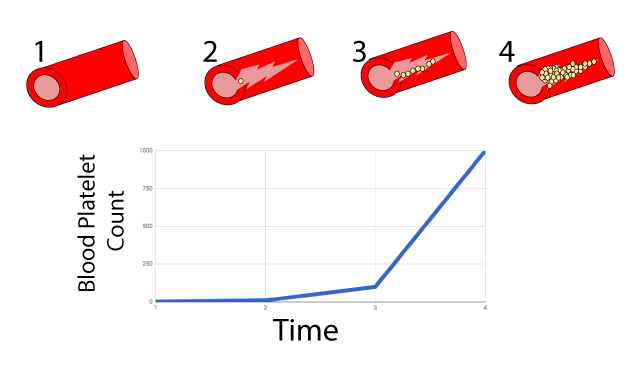
The formation of blood clots is an example of positive feedback. When a blood vessel wall is damaged, the damaged blood vessel wall releases chemicals that initiate the formation of a blood clot through platelet aggregation (see “2” above). As more platelets gather, more chemicals are released, speeding up the process (diagram 3). The process accelerates until the blood vessel wall is completely sealed and the positive feedback loop has ended. The exponential form of the graph illustrates the positive feedback mechanism (from Wikipedia).
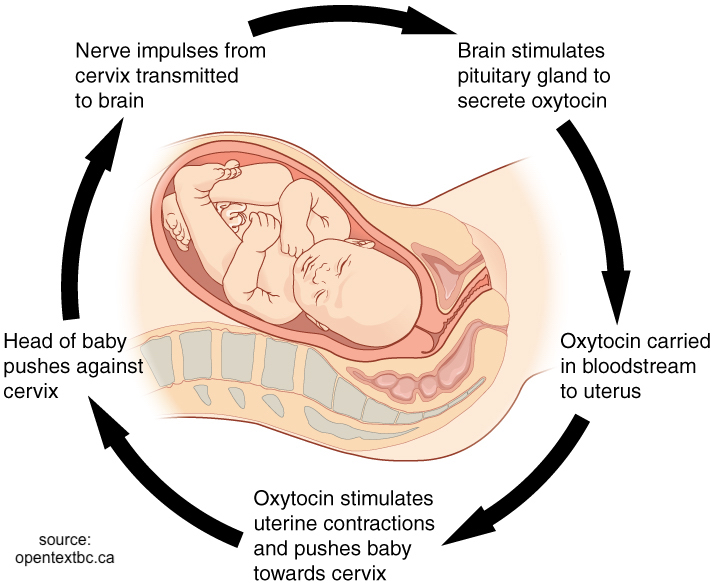 Another temporary positive feedback loop is also unleashed during the birth process. Start on the left side, at about 8 o’clock. As the baby’s head pushes toward the cervix, oxytocin unleashes uterine contractions that push the baby’s head against the cervix with even more force, causing the release of more oxytocin. The process ends when the baby is pushed completely out of the womb during the delivery process.
Another temporary positive feedback loop is also unleashed during the birth process. Start on the left side, at about 8 o’clock. As the baby’s head pushes toward the cervix, oxytocin unleashes uterine contractions that push the baby’s head against the cervix with even more force, causing the release of more oxytocin. The process ends when the baby is pushed completely out of the womb during the delivery process.
Within an organism, all positive feedback loops are necessarily limited by some maximum value or endpoint. That can be harder to see in positive feedback loops that work at the planetary or global level, but it’s true for those as well. Think of population growth. Assume a population (of any type of organism) that grows by a constant percentage. Whatever that percentage is, there will be more people at the end of a generation than there were at the beginning. During the next generation, this larger population will grow at the same rate but add even more people. At a certain point, however, the population will exceed the carrying capacity of the environment, bringing population growth to a halt.
We’ll look again at this process, known as exponential growth (along with its limits), in an upcoming module about population growth.
Links
- Feedback/Homeostasis 2: Blood Glucose Regulation (the next tutorial in this series)
- Feedback/Homeostasis Main Menu
